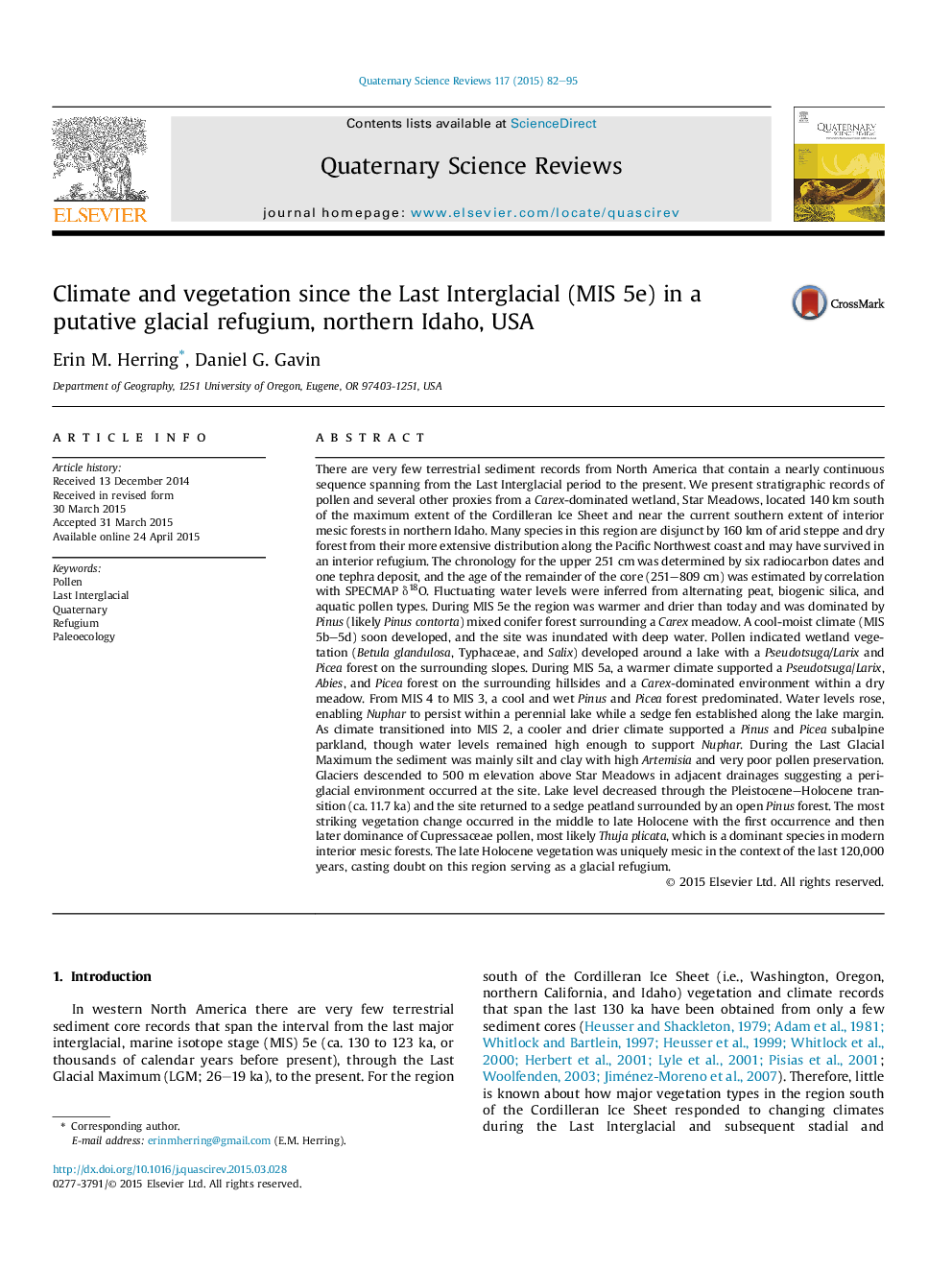| کد مقاله | کد نشریه | سال انتشار | مقاله انگلیسی | نسخه تمام متن |
|---|---|---|---|---|
| 6446728 | 1640817 | 2015 | 14 صفحه PDF | دانلود رایگان |
عنوان انگلیسی مقاله ISI
Climate and vegetation since the Last Interglacial (MIS 5e) in a putative glacial refugium, northern Idaho, USA
دانلود مقاله + سفارش ترجمه
دانلود مقاله ISI انگلیسی
رایگان برای ایرانیان
کلمات کلیدی
موضوعات مرتبط
مهندسی و علوم پایه
علوم زمین و سیارات
زمین شناسی
پیش نمایش صفحه اول مقاله

چکیده انگلیسی
There are very few terrestrial sediment records from North America that contain a nearly continuous sequence spanning from the Last Interglacial period to the present. We present stratigraphic records of pollen and several other proxies from a Carex-dominated wetland, Star Meadows, located 140 km south of the maximum extent of the Cordilleran Ice Sheet and near the current southern extent of interior mesic forests in northern Idaho. Many species in this region are disjunct by 160 km of arid steppe and dry forest from their more extensive distribution along the Pacific Northwest coast and may have survived in an interior refugium. The chronology for the upper 251 cm was determined by six radiocarbon dates and one tephra deposit, and the age of the remainder of the core (251-809 cm) was estimated by correlation with SPECMAP δ18O. Fluctuating water levels were inferred from alternating peat, biogenic silica, and aquatic pollen types. During MIS 5e the region was warmer and drier than today and was dominated by Pinus (likely Pinus contorta) mixed conifer forest surrounding a Carex meadow. A cool-moist climate (MIS 5b-5d) soon developed, and the site was inundated with deep water. Pollen indicated wetland vegetation (Betula glandulosa, Typhaceae, and Salix) developed around a lake with a Pseudotsuga/Larix and Picea forest on the surrounding slopes. During MIS 5a, a warmer climate supported a Pseudotsuga/Larix, Abies, and Picea forest on the surrounding hillsides and a Carex-dominated environment within a dry meadow. From MIS 4 to MIS 3, a cool and wet Pinus and Picea forest predominated. Water levels rose, enabling Nuphar to persist within a perennial lake while a sedge fen established along the lake margin. As climate transitioned into MIS 2, a cooler and drier climate supported a Pinus and Picea subalpine parkland, though water levels remained high enough to support Nuphar. During the Last Glacial Maximum the sediment was mainly silt and clay with high Artemisia and very poor pollen preservation. Glaciers descended to 500 m elevation above Star Meadows in adjacent drainages suggesting a periglacial environment occurred at the site. Lake level decreased through the Pleistocene-Holocene transition (ca. 11.7 ka) and the site returned to a sedge peatland surrounded by an open Pinus forest. The most striking vegetation change occurred in the middle to late Holocene with the first occurrence and then later dominance of Cupressaceae pollen, most likely Thuja plicata, which is a dominant species in modern interior mesic forests. The late Holocene vegetation was uniquely mesic in the context of the last 120,000 years, casting doubt on this region serving as a glacial refugium.
ناشر
Database: Elsevier - ScienceDirect (ساینس دایرکت)
Journal: Quaternary Science Reviews - Volume 117, 1 June 2015, Pages 82-95
Journal: Quaternary Science Reviews - Volume 117, 1 June 2015, Pages 82-95
نویسندگان
Erin M. Herring, Daniel G. Gavin,